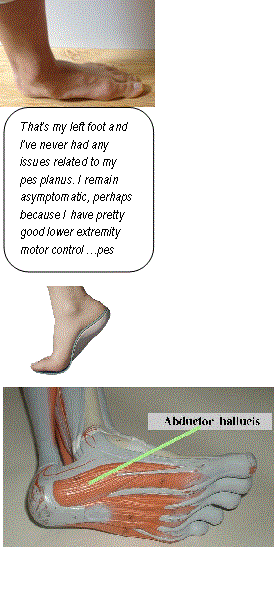My Debate with a Podiatrist!
Reference:1) Jung DY, et al. Effect of foot orthoses and short-foot exercise on the cross-sectional area of the abductor hallucis muscle in subjects with pes planus: a randomized controlled trial. J Back Musculoskelet Rehabil. 2011;24(4):225-31.
2) Mulligan EP, Cook PG. Effect of plantar intrinsic muscle training on medial longitudinal arch morphology and dynamic function. Man Ther. 2013 Oct;18(5):425-30.
Years ago I had a spirited debate with a well known podiatrist who absolutely rejected the hypothesis that intrinsic foot muscle (IFM) training could have any effects on the medial longitudinal arch or pronation.
The podiatrist strongly believed that orthotics were the only true solution to correcting excessive navicular drop and pronation.
Although I personally have pes planus (see my foot on right), I could care less about the height of my arches; what is important to me is the neuromuscular control of my feet and lower extremity.
I proposed to the podiatrist that jumping into orthotics may potentially further impair the normal muscular activation of my IFM. The podiatrist gave me a you’re an idiot look!
He said, “You were born with pes planus and will never change that with silly foot exercises.”
Was he correct or incorrect?
He was correct in saying that no matter how much I train my IFM, I will always pronate and have pes planus. Where he was wrong, is that yes I pronate a lot, but by having good IFM control, I like to believe that I pronate with CONTROL!
I wish 10 years ago I had these two studies to quote and give as references to the podiatrist.
IFM Study #1
This study examined the effects of foot orthotics and IFM exercises on the cross-sectional area of the abductor hallucis (AbdH) muscle and strength of the flexor hallucis (FH) in subjects with pes planus.
Subjects with pes planus were randomly assigned to one of 2 groups for 8 weeks.
i) Foot orthotics
ii) Combined foot orthotics and IFM exercises
Result #1: The cross-sectional area of the AbdH muscle and the strength of the FH significantly increased after the intervention in both groups
Result #2: The cross-sectional area of the AbdH muscle and the strength of FH were significantly greater in those who also received IFM training
Conclusion: Perhaps IFM retraining is not a waste of time and that it is possible to increase the size and strength of the foot muscles.
Clinical Relevance: We don’t yet have a study to show if improvements in size and strength of the IFM actually improve symptoms and functional scores in those with over-pronation related issues.
IFM Study #2
They looked at the effects of a 4 week intrinsic foot muscle strengthening (not towel toe curls) on 42 asymptomatic feet.
After 4 and 8 weeks the subjects had significantly reduced navicular drop and significant improvements in their static and dynamic single leg balance.
In your face podiatrist!
Now I just need a study to support IFM training in the symptomatic population.
You may be asking so how does one strengthen the IFM? Here are 5 simple suggestions Search in the Library for “IFM”
Posted on: March 10, 2014
Categories: Foot & Ankle


